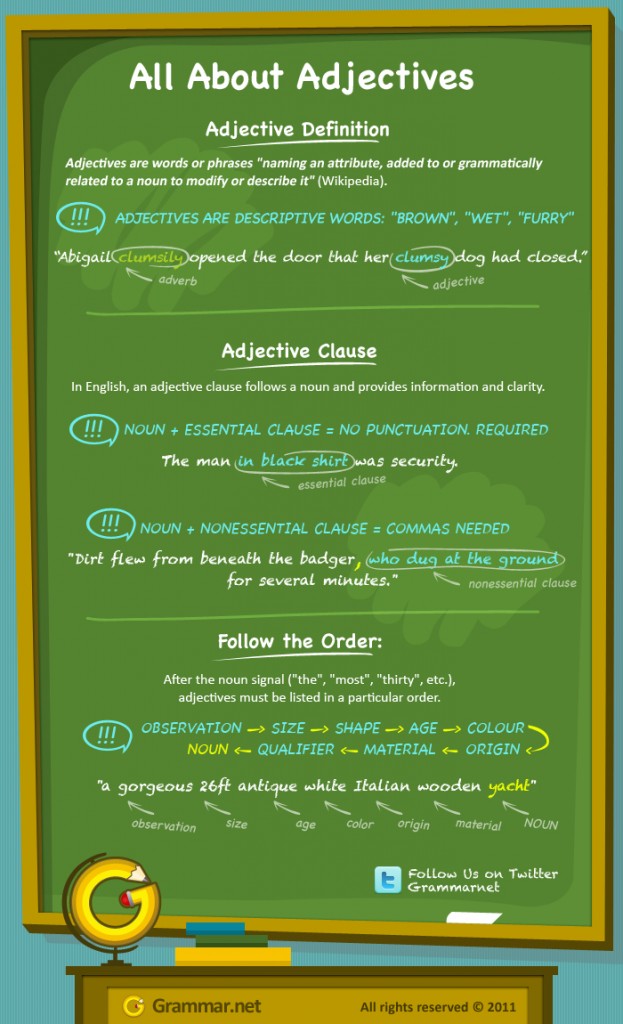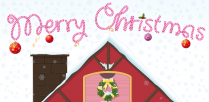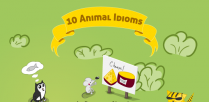Adjective Definition
By Wikipedia’s definition, adjectives are words or phrases “naming an attribute, added to or grammatically related to a noun to modify or describe it”. In short, adjectives are descriptive words. Many confuse them with adverbs, but adverbs cannot describe nouns and generally end in “-ly”. Rule of thumb: if it cannot describe your dog, it is an adverb. “Brown”, “wet”, “furry”: all adjectives. “Clumsily”: an adverb that cannot describe your dog. “Clumsy” can, as it is an adjective.
Here is an example that shows how both work:
“Abigail clumsily opened the door that her clumsy dog had closed.”
To download high resolution poster click here.
Embed this image to your site:
Adjective Clause
In English, an adjective clause follows a noun and provides information and clarity. “Essential clauses” are small, necessary, and do not require any punctuation.
“The man in the black shirt was security.”
“People who live in glass houses should invest in curtains.”
“Frankie the dog dived for a brownie that had fallen off the table.”
“Nonessential clauses” require additional punctuation in the form of commas.
“Myrtle, the woman who had set my hair on fire, stood in the corner and laughed at me.”
“Dirt flew from beneath the badger, who dug at the ground for several minutes.”
Predicate Adjectives
A predicate adjective follows the noun it describes and is linked to that noun with a verb. The easy way to remember this is the phrase “subject/predicate”: the predicate follows the subject just as predicate adjectives follow their nouns.
“The chickens were friendly.”
“Phyllis’ clothes were new.”
“I was extremely composed, although my hair was utterly charred.”
Order
After the noun signal (“the”, “most”, “thirty”, etc.), adjectives must be listed in a particular order. Below, this order is shown with a few examples of adjectives:
Opinion: Lovely, useful, silly, good
Size: Tall, tiny, gigantic, medium
Age: New, prehistoric, immature, new born
Shape: Round, tube-shaped, flat, square
Color: Blue, pale, speckled, yellowish. Some sources say it is alright to interchange “age”, “color”, and “shape” as long as the sentence is not awkward.
Origin: Irish, aquatic, northern, urban
Material: Leather, snow, plastic, wooden
Purpose: Words used to explain a noun’s use comes right before the noun and includes combinations such as “fishing rod”, “training wheels”, or “cooking pots”. Purpose adjectives often end in “-ing”.
Fun With Adjective Order
Here are a few sentences illustrating order; the last two are hard core, but all adjectives are in proper order.
“My sister was wearing some ugly old brown fake-leather shoes.”
“Inside the shed was a battered black Canadian fishing pole.”
“My first car was a horrid ancient heap of orange urban metal.”
“The little white kitten caught a big old rat in the scary dark apartment basement.”
“At the museum, my least favorite piece was a strange huge lumpy multi-colored urban stone sculpture.”
Adjectives Gone Wild
Care must be taken to ensure that adjectives do not point to the wrong noun. The most-quoted illustration of improper use of adjectives is this sentence (it is so famous that it was even used as a movie title):
“Throw Mama from the train a kiss.”
Instead of throwing a kiss to Mama, it sounds like you just pitched Mama off the train. Poor Mama! There are several ways to rewrite this sentence so that it makes better sense (and is less hurtful to Mama). How many different ways can you come up with?








